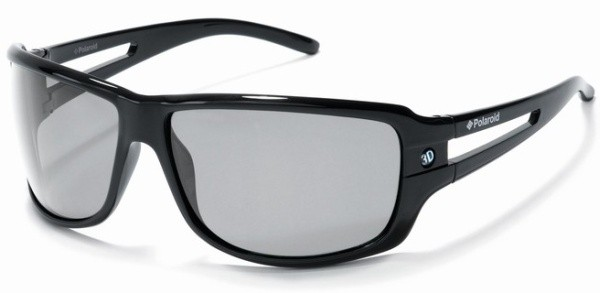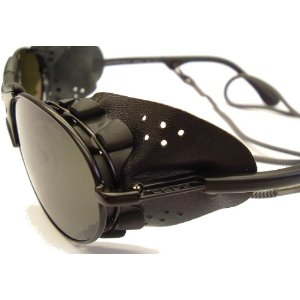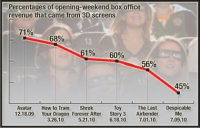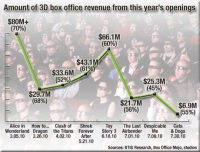Film Critic Roger Ebert wrote an impressive article about 3D technology in movies. It appears in Newsweek, an American magazine that is considered sometimes serious.
In it, he leads with his top negative criteria, tells us that he is committing heresy by saying these things, then repeats these criteria with an additional sentence or two. These are some of the arguments that counter his logic.
1. IT’S THE WASTE OF A DIMENSION.
Perspective is one of more than a dozen clues that we use to discern whether an object is closer or farther from the viewing position. One imagines that when Renaissance painters such as Michelangelo and de Vinci brought back and experimented with perspective, a lost technique since the fall of the Roman Empire, that the same arguments were made.
But this point is not valid any more than saying that it was a costly mistake bringing color into the film world, or pictures to stories that were previously done well over radio waves. The real point is that when a director is able to get an audience immersed in the story, the technology doesn’t matter.
This is not the forum for describing exactly how there is no such thing as color, that it is all a trick done in the mind. But the same roles apply here. The mind can put the texture of a dress into a radio story, or the color of Bergman’s eyes into the last scene of Casablanca, and the depth required to allow an actor to roll down a hill, when logic says that a screen is flat, and gravity should make them fall, like down a cliff.
His point about Lawrence of Arabia is an interesting choice. Early in the transition to digital, that exact example was used to point out the difference between film and digital; that from a film our eyes would see a blurred object and skip through some logic to determine that it is a man on a horse descending from a dune. In digital, depending on the resolution, this would start as a square pixel (picture element), then keep adding pixels until there were enough information to allow it to take some form in the mind. This included an argument that said that the film Titanic could not be digitized for wide-screen digital presentation without smearing all the digital elements in the background, elements which were done with a technology that was just over the limit for what it was needed for (film release), but would be under the limit for the resolutions and technologies of digital release 5 years later.
2. IT ADDS NOTHING TO THE EXPERIENCE.
Again, he is right, but again, wrong. But I am prejudiced, as I have seen the final scene of Casablanca that was painstakingly converted to 3D. After that, I was converted from being anti-3D… knowing that if it was always done this well, if it always looked this natural, then this was the way it should be done.
He is asking the wrong question. Not what would it gain, but what is the more natural way to immerse an audience? The answer is that we see with 2 eyes, that we see with convergence of two pictures delivered to the brain that are slightly different, and the mind is relied upon to work out the differences.
Yes, the mind can discern depth by interpreting shades of colors and from shadows that move across objects, and by interpreting which pieces are blocking which other pieces in the frame. We can tell by the subtle differences in the fringing that occurs at the edges of objects (again, going back to the subtle clues that mark di Vinci’s work.)
All in all though, adding a second picture that is slightly different which gives us the natural clue that convergence brings…by its nature and by our nature…adds something to the experience.
3. IT CAN BE A DISTRACTION.
Now he is starting to have a reasonable argument. He should have led with this.
The current evolution of 3D is a technology searching for ways to do the right thing in an economical way. Since animated movies are no longer painted cell by cell, frame by frame, but rather created in computers using 3D technology anyway, this was the most natural starting place for movies to present 3D. Simultaneously, CGI (Computer-Generated Imagery) was on a parallel track, getting quite sophisticated. It was the next logical step. A few tools were headed there.
But the challenges of getting the subtlety required, a subtlety not required by animation, meant that Cameron was developing technology on-the-fly, going through at least 3 generations of camera equipment, and pushing every other production and post-production envelop along the way. An evolution without Cameron’s work would have taken another 5 or 10 years.
It would be great to develop a master class that would discuss all the different technologies available to create 3D movies, centered on the many methods that Cameron used in Avatar. But this isn’t the place. Suffice to say that it takes time and money to do it well. And the recent Alice In Wonderland is a great launch to a short explanation of what Ebert’s real point 3 should be.
In making movies, the long standing complaint was that audio was always given the short shrift, forced to do months of work in a week or two, and at the last second, with the director and the executives from the lot all breathing flame down the backs of the mixers and crew.
According to one 3D house, this time it was their work that got the squeeze, and the product was less for the experience. It was known that Alice would have to go to a shop that takes each frame, makes a series of discrete elements from it, and expands upon the 3D clues already there by giving the slightly different view required to place all the objects in space. It is a people intensive, time intensive process. If you have less time, you need more people, but those people need training and experience, and a place to sit with computers and support personnel.
The story goes that Alice was tossed to the crew later than was promised, too late to do the 3D work that they promised, and too late to get the people and equipment to do it right. So, part of the work had to be farmed out to another facility who was given the task of ‘do the best you can’ for a large part of the movie, while the first group did the detailed work on the elements that were determined to be most critical.
It is obvious while watching the movie. Some parts are very well done, and other parts are like Ebert says; people and objects moving between segmented planes of other objects. Interestingly, the effect is somewhat like Burton’s 3D Christmas Story from a few years before…some might guess that he didn’t object to the intra-scene effects.
There is a 2nd argument that Ebert wraps into this, partly correct and partly not. Using different focus on different planes is indeed a clever directorial tool. It is no less with digital as with film, though digital cameras are more touchy in this regard. So, to begin, this isn’t entirely a 3D issue. 3D equipment is no less capable of shifting this focus. In fact, in some ways it is more capable, allowing the director to shift the convergence and focal and ‘in focus/out of focus’ point in post-production. So, whether that deprives a director of a tool to guide our focus is debatable at best and hyperbole at worst.
4. IT CAN CREATE NAUSEA AND HEADACHES.
Again, I shouldn’t tell a professional like Mr. Ebert how to write, but a paragraph is meant to contain one focus. In this arguments paragraph he starts with 3D TV, and the Consumer Electronics Show. Then it switches to an odd, generalized and possibly incompletely or erroneously stated argument by a scientist, then washes the blood across the screen with a Consumer Report statement about eyestrain that blasts against 3D movies.
The conversation should stay on 3D movies. 3D TV is a different animal, moving on a different evolutionary path. That they may share media in the future shouldn’t make it allowable to get their medium technology confused. Suffice to say that 3D TV is somewhat harder and somewhat easier to do technically, and that there are a lot of considerations that need to be worked out.
What both do share is a lack of million person studies to tell the if and what and why of headaches and eyestrain. Any number that any person uses in this regard, for big screen movies or television, is pulled out of their hat…and if they aren’t wearing a hat…
There are a lot of numbers thrown around in the popular press, and one sometimes suspects data creep. Some data points out that there are some people who just don’t see the 3D effect at all. There are guesses that this is about 8%, and possibly 12-15%. Since one of the technologies works using a sophisticated color filter, this number could raise or lower with the number of people who have color problems in general.
Who gets headaches though, and why? Well, first, not enough people got headaches to make them leave Avatar in droves. And second, if there were studies that Dr. Micheal Rosenberg could have pointed to, I’m certain that Mr. Ebert would have used the enabling technology of hyperlinking to point us to them. For the most part, they don’t exist. There are a few done a colleges (with college age eyeballs) which point to areas that require further study. But there are none which have taken the general population and figured this out.
One area that is known to be a weak point is that the distance between our eyes is different, but this ‘inter-ocular’ distance is chosen for us at the movies. Children obviously have a different space between their eyes than adults do, but everyone gets the same glasses.
At the recent industry event, ShoWest in mid-March, several companies showed glasses which were more comfortable, and better suited for different faces. But 1=1. You can’t change one part of the 3D equation without effecting other parts. What happens if you change the glasses for a child? Frankly, that study hasn’t been done. Does it hurt them, like the story of Carl Reiner’s Opti-Grab invention in The Jerk? Probably not, since the gaming industry has a lot of kids of a lot of ages already wearing 3D glasses. It will change the perceived depth (as compared to someone else with different eye spacing), but it doesn’t seem to induce cross-eyed or wall-eyed individuals who can’t find the popcorn box.
But as we will see with Ebert’s other arguments and our discussion, 3D is part of a system that has evolved to the point of ‘kinda works’, introduced as digital projection was being adapted…and that technology has only recently left the sphere of ‘just kinda works’ itself.
5. HAVE YOU NOTICED THAT 3-D SEEMS A LITTLE DIM?
Phew. There’s a whole bunch of ‘inside baseball’ in this paragraph, much of it that doesn’t belong to this discussion. But since it was thrown in, it shows the confusion that a neophyte like Mr. Ebert has to go through – How can any of us mere mortals get along? (Actually, I can’t believe that he doesn’t know what a foot-lambert (ftL) is. In his decades as a professional in front of a screen reflecting light, he must have run across the common term that the professional standard is measured in.)
Notwithstanding, he and Lenny Lipton are partially right, and he has partially explained the reason. He hasn’t mentioned that new technologies were developed after Mr. Lipton left one of the major equipment developers, which has doubled the light to the screen, or that recently released projectors are able to give more light for the same electrical consuption. Nor does he mention that even though a little dim, the technique works.
On the other hand, this argument shouldn’t be slighted since it is the most valid argument. It is the reason that the majority of 3D screenings are done in mid-sized auditoriums. A larger auditorium would need two projectors beaming to fill the screen. If the technologists involved with the technology had their way, this would be the first area to change. The other desire to change the frame rate, which is made later in the article, would also be on the list, but not unanimous and certainly further down.
It also reminds one of the Yogi Berra quote; In theory there is no difference between theory and practice. In practice there is. The standard for light level to the theatrical screen is recommended by the Society of Motion Picture and Television Engineers at 16 ftL, but there are caveats. First, it is set with no film in the projector. So actually, the standard is about 14 ft-L with clear film. Digital Cinema projectors project white, they don’t use ‘no film’ or clear film.
In a seminal book titled Understanding Digital Cinema by the late Charles S. Swartz, he points out that further study is required to determine if “whether increasing the Digital Cinema setting to 14 ftL improves the visual match to projected film.” They were using 12 ftL at the time.
In fact, the DCI (Digital Cinema Initiative, a study group funded by the 6 major studios) made their recommendation at a nominal 14ftL, ± 3.0 ftL, at the center. (Like other standards, it allows for a uniformity reading of 70% of center at the corners and sides.) The point being, don’t scare me with the difference of big numbers when the reality is less.
In fact, the DCI Stereoscopic Addendum recommendation doesn’t give a luminance value, no doubt presuming it would change. What this recommendation does allow is where our experts Lipton and Ebert fall down, since it does show that there is a significant allowance for color degradation from the 2D standard. That may have been too much for Mr. Ebert to explain in a pop magazine, but it should have been worth the try instead of acting the Luddite.
Going back to the luminance level of 3D–Complain at your cinema. 3D can and should be displayed brighter. If there are no complaints, the standard will remain stuck at this least of possible worlds level.
Instead of changing the brightness as the technology advances (which it has), cinemas will move the movies into a larger room and keep the the same low brightness. This will give more people an social opportunity to sit with a larger crowd (I’m certain that is what the cinema owners are interested in), but it will not be all that 3D can and should be. (Presuming, of course, that you will agree with the author’s opinion that bringing the light level above a higher threshold does change the experience greatly. Again…no studies.)
Thus, Mr. Ebert blows his one good argument and his one great Howard Beale opportunity.
6. THERE’S MONEY TO BE MADE IN SELLING NEW DIGITAL PROJECTORS.
[1] These projectors are not selling themselves. [2] There was initial opposition from exhibitors to the huge cost of new equipment and infighting about whether studios would help share these expenses. [3] Some studios, concerned with tarnishing the 3-D myth, have told exhibitors that if they don’t show a movie in 3-D, they can’t have it in 2-D. [4] Although there’s room in most projection booths for both kinds of projectors, theaters are encouraged to remove analog projectors as soon as they can. [5] Why so much haste to get rid of them? [6] Are exhibitors being encouraged to burn their bridges by insecure digital manufacturers?
Teaching the movie-going audience about the nuance that they should be aware of when watching a movie is Mr. Evert’s one purpose, and he is listened to because he usually does it so well.
In this case, he fails, as there is not one completely true statement in that paragraph. The numbers in Ebert’s arguments above are the authors, to help analyze the statement.
[1] For some early adopters, digital projectors did indeed sell themselves…by the thousands. Digital Cinema brought crowds of people to those theaters who had the intelligence and capacity of teaching their audience, sometimes on a 5:1 ratio of their normal city-wide competition numbers.
[2] “There was initial opposition from exhibitors to the huge cost of new equipment…” Partially true, but so grossly understating the case and making it past tense when it is ongoing at many levels including exhibitors, but also at government levels, that it is a false statement.
In a nutshell, the quick argument is that digital equipment costs 3X what film equipment costs and needs replacing a lot quicker. Studios get the savings, since the cost of prints and distribution is in the billions per year. To offset this, the studios have offered some cinemas a method of reimbursing the cost of some digital equipment, a method known as the Virtual Print Fee (VPF). A VPF is not paid for 3D equipment. A VPF is not paid to cinema facilities who do not get 1st run prints, since the studios don’t normally have a cost associated with them playing a movie…therefore no cost to reimburse. They don’t pay a VPF for equipment that is playing entertainment not of their making. That is, if a facility were only to play live-opera, or sports, or movies from 3rd world communities (made much easier with digital distribution techniques), then a VPF isn’t warranted. In fact, there is no grand “Studios” in this regard. Each studio negotiates contracts individually. So, not only doesn’t Warners not want to pay for movies made by Pathé, they don’t want to pay for movies made by Fox.
[3] It is hard to parse this sentence since it presumes facts and slurs not in evidence. It should also be noted that any negotiation between studio and exhibitor would make the water wars of Chinatown seem like childs play. Anything can be said, everything is on the table. The presumption is that an auditorium must guarantee to play several weeks of Jaws Sequel 14 in order to get the next release of Harry Potter. The statement that there is a 3D myth is presumably built on the idea that there is little ongoing evidence that 3D pulls in more people who will spend more money. Since these deals are made months in advance anyway, and since the increase from single to double digit releases of 3D only happened this year, this is a red herring argument at best.
[4] Let’s face it. If you have to build a new cinema, or if you have to replace old equipment, are you really going to fight against the digital trend? Reality: The largest film projector manufacturer has left the field. Maybe they are involved in the conspiracy since they are also the largest manufacturer of digital projectors, but let’s face reality. Film is a dying technology.
Film, a very sophisticated piece of plastic, uses chemicals that are getting more expensive. (Shall we write about the alleged run on silver by JPMorgan, who is also funding thousands of digital cinema installations? Conspiracy again!) It is difficult and expensive to handle, and even in the best of hand it degrades with each showing. 10 years ago, perhaps even 5 years ago, one would put the film projector in the center port window and relegate the digital to the side. That just isn’t today’s reality.
[5] That environmental nightmare of chemicals and shipping tons of film around the world in secure airplanes and trucks instead of hard disks and eventually satellite and fibre is only part of the haste to get rid of film equipment. The ability of story tellers to make a movie or documentary for less, and distribute to thousands of places for less than it cost to make 5 prints is only one opportunity, plus the ability for communities to see live broadcasts of well done opera and sports that digital equipment gives them.
The cost of film has gotten too expensive as digital cameras have gotten better at taking their place. One can mourn its loss, since there is a hundred years of tricks and gimmicks and a hundred years of our eye/brain/mind learning to convert its images to a reality. But the transition will bring more benefits than it takes away.
[6] “…burn their bridges by insecure digital manufacturers.” One would have presumed that Mr. Ebert is established enough that he doesn’t have to get paid by the word. But I can think of no other reason for this strawman of an argument. IS he implying that there is collusion between the manufacturers and the studios so grand that the colossus of the exhibitors must not only comply but also stay silent? Bigger players have come onto the field and left it than the players who remain. Boeing and Qualcomm appeared and disappeared, leaving a lot of upstarts to take their place. Technicolor remains as a “print” maker and distributor (among other talents), but their film areas are left in havoc. Texas Instruments has spent millions getting the technology up to the evolved standard, but they weren’t known for their clout in the industry. (Conspiracy players – check to see how many TI printers were on the studio lots and if they have a chip set to fail if the studios didn’t back DCinema.)
But, really, Ebert’s arguments are about the digital transition, not about 3D. That studios decided to make more of their movie slate into 3D, before they found that movie patrons would pay more for the 3D privilege, is argument enough, but that gets to the next argument.]
7. THEATERS SLAP ON A SURCHARGE OF $5 TO $7.50 FOR 3-D.
Ah, now the rub. Money for nothing, Kicks for free.
It is hard to speak about Titans without saying that they experimented with a technology, a different technology from Alice, yet from a post production house that derived elements for Avatar…experimented and seemingly failed.
But that doesn’t prove that the studios only did it for the extra $5.
The surcharges for digital and then 3D started slowly. First it was 1 euro or dollar to compensate for the extra stewards and stewardesses who were needed to hand out and retrieve the 3D glasses. Then when cinemas started with the technology that required sterilizing glasses between use, they felt justified adding a little more, especially since no one seemed to complain.
What Mr. Ebert doesn’t say is that the add-on equipment for the 3D capability costs another 20-30 thousand dollars…in some cases more. In addition to the equipment from Dolby, MasterImage, RealD or XpanD, two of those systems require replacing the screen with what is called a ‘silver screen’ to hold the circular polarization that the systems use. Those two systems use cheaper ‘throw-away’ glasses, but the first and last of those systems use expensive, but reusable, glasses that cost 10s of euros (or dollars.)
Are they making more money than they invested? Do the studios take half the money that the exhibitor charges? Unless Mr. Ebert is changing his arguments to a rant on capitalism or the manner that studio/exhibitor deals are made, this argument is using too wide a brush to make a point.
[I hope that you have gone to page two of the NewsWeek article by now. Arguments 8 and 9 are multi-paragraph, though otherwise not unlike the other comments.
8. I CANNOT IMAGINE A SERIOUS DRAMA, SUCH AS UP IN THE AIR OR THE HURT LOCKER, IN 3-D.
What a critic can’t imagine is not the point. It is what a storyteller who uses a technology can imagine that is important.
There is also another concern. There are some odds that this 3D trend is not a gimmick and that it will continue to evolve to the point that it becomes the norm. If that is the case, no storyteller will want his/her product to be “dated”. No story teller is going to make anything in 4:3 TV size for the same reasons.
“He is a master of cinematography and editing. Other directors are forced to use 3-D by marketing executives. The elephant in that room is the desire to add a surcharge.” “A scam to justify the surcharge.”
These arguments aren’t borne out by fact. Not only are surcharges are more recent than the decision to increase the number of 3D movies, but no one can tell directors of the caliber of Tim Burton or Martin Scorsese or Steven Spielberg or Werner Herzog what to do. Creative people like to experiment, some more than others. Do all experiments succeed? Do all movies make back their costs? When they don’t, was it because the studios forced things on the directors? Well, sometimes. But that is not the point that Mr. Ebert is making.
9. WHENEVER HOLLYWOOD HAS FELT THREATENED, IT HAS TURNED TO TECHNOLOGY: SOUND, COLOR, WIDESCREEN, CINERAMA, 3-D, STEREOPHONIC SOUND, AND NOW 3-D AGAIN.
That is big and deep and partly true, and partly revisionist history. It often should be seen the other way. Technologists get ideas, studios take them up, they make money, people think, “Gee, I’ll go to movies again.” But the reality is that these technology advances come without some group of studio heads coming down from Olympus to the rat-infested confines of technologists, with a declaration that their family dog will be shot if they don’t save Hollywood with a 9ml technology fix.
Further, studies have shown that nothing, none of the technologies Ebert mentioned above have done anything to affect the long-term curve of “Butts in Seats”, and further, he is missing the only technology shift that has affected that curve: stadium seating.
This is not to say that his point is wrong about cinema being under siege to Blu-ray and HD cable and home cinema projectors (not to mention flat-screens), and the closing window between wide-screen and DVD releases, and a horrible economy. Studios and exhibitors needed a killer-app, and 3D is a welcome just in time.
But it should be noted that the trend lines for income and butts-in-seat have been up for a couple years running (though I would love to have seen what the numbers would have been if Avatar had been an average blockbuster.)
Ebert closes with two paragraphs that bring him back to reality. The first deals with a technology shift to more frames per second. He thinks that he should be done with a film-based system named MaxiVision48. He points out that Douglas Trumbull had developed and promoted a higher frame rate system (Showscan), and fails to mention that Cameron has mentioned in interviews that a higher frame rate would be the proper direction for digital.
He also doesn’t note that the latest standards and capabilities for digital presentation allow for lower and higher frame rates, and many in between.
“These systems are so good that the screen functions like a window into three dimensions. If moviegoers could see it, they would simply forget about 3-D.”
Maybe Roger is capable of having his Howard Beale moment. Combined with the next paragraph, an ode to the good times past, and a screed against that “younger Hollywood is losing the instinctive feeling for story and quality that generations of executives possessed. It’s all about the marketing.”
Move to Europe Roger. Watch French (and Spanish and Hungarian and Italian) movies. Quit being so insular, damning the world after only inspecting the games and comic book sections of the store.
If digital cinema continues to follow the classic trends of new technology as it has, it won’t reach 50% saturation for another 18 months, at best. The last 50% are not necessarily fall over like dominoes. They would be a great market for EbertFilms. I would invest, though that wouldn’t finance more than a few connectors. But he has more than a few years to prove that well made films with a great story, done on a film based system, can take over the market. I’d love to see it.
But it is not going to happen.
This Series now includes:
The State of Digital Cinema – April 2010 – Part 0
The State of Digital Cinema – April 2010 – Part I
The State of Digital Cinema – April 2010 – Part II
Ebert FUDs 3D and Digital Cinema






 Both articles and their references are worth reading, but one should remember that when 4 or 5 movies come out in a row, and a guy has to drop over $30 for a pair of tickets plus all the other expenses, or a family drops about $100 per movie for four, that a recession might be worth a mention…regardless of how fun being right while knocking 3D happens to be.
Both articles and their references are worth reading, but one should remember that when 4 or 5 movies come out in a row, and a guy has to drop over $30 for a pair of tickets plus all the other expenses, or a family drops about $100 per movie for four, that a recession might be worth a mention…regardless of how fun being right while knocking 3D happens to be.
